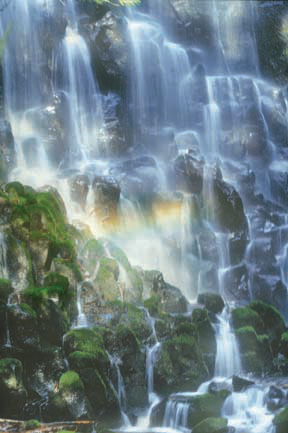
High on the side of Mt. Hood.
About the Hike: Like white lace, 120-foot Ramona Falls drapes across a stair-stepped cliff of columnar basalt. The very popular trail to the shady grotto of this Mount Hood cascade starts out in a mossy alder forest beside the Sandy River's bouldery outwash plain. A loop trail to the falls follows a portion of the Pacific Crest Trail.
Difficulty: The difficult 7.1-mile loop to the falls gains 1000 feet of elevation.
Season: Open last April through October.
Getting There: From Portland, take Highway 26 toward Mt. Hood for 42 miles. At the village of Zigzag, turn left onto East Lolo Pass Road. After 4.2 miles turn right onto paved Road 1825, and in 0.7 mile turn right across the Sandy River bridge. Continue 1.8 miles on what is still Road 1825, and then fork left onto Road 100 for half a mile to a large parking area at road's end
Fees: A $5-per-car Recreation Fee Pass (Northwest Forest Pass) is required.
Hiking Tips: After 1.2 miles the path crosses the Sandy River on a temporary bridge that's removed each winter to avoid floods. A few hundred yards beyond the bridge you'll reach a trail junction. The shortest route to the falls is the horse trail to the right, but it's less scenic, so leave it as a return route.
 Instead veer left on a path that traverses a lodgepole pine forest to the wild Muddy Fork of the Sandy River. Here, turn right on a trail that soon follows the mossy bank of Ramona Creek-a delightful woodsy stream that leads up to the base of the falls. Although camping is banned within 500 feet of Ramona Falls, a side path leads to designated campsites to the south.
Instead veer left on a path that traverses a lodgepole pine forest to the wild Muddy Fork of the Sandy River. Here, turn right on a trail that soon follows the mossy bank of Ramona Creek-a delightful woodsy stream that leads up to the base of the falls. Although camping is banned within 500 feet of Ramona Falls, a side path leads to designated campsites to the south.
History: When Sam Barlow was pioneering a wagon route around Mt. Hood as an Oregon Trail shortcut in 1845, his group ran out of time, left their wagons on the east side of the mountain, and hiked past present-day Timberline Lodge and Ramona Falls in order to reach the safety of the Willamette Valley before winter set in. The pioneers who named the Sandy River thought its milky color was caused by sand. In fact the stream carries glacial silt-rock powdered by the weight of Mount Hood's glaciers.
Geology: Ramona Falls has such a lovely shape because it cascades over the remnants of a columnar basalt lava flow. When basalt lava cools slowly enough, it fractures into a hexagonal pattern perpendicular to the cooling surface. Later erosion has broken these basalt columns into a stair-stepped honeycomb.
By William Sullivan
